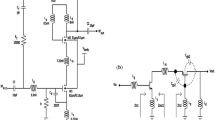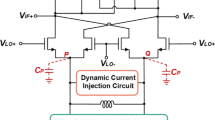Abstract
This paper demonstrates a component of radio frequency transmitter called up-conversion mixer with high conversion gain and ameliorate linearity. The novelty of given circuit architecture is that CMOS transconductance amplifier is used to improve the overall conversion gain. For changing to an unbalanced baseband signal (UBBBS) to differential balanced signal (DBS), a passive balun circuit has been used. The circuit operates at frequency 2.4 GHz, and the local oscillator frequency is 2.3 GHz. The conversion gain and IIP3 of the proposed circuit has been achieved 21.4 dB and 4.24 dBm respectively. The proposed circuit is designed and simulated using Cadence Analog and Digital System Design Tools with PDK UMC90 nm CMOS Technology. This circuit is operational on the rail-to-rail power supply of ±1.8 V.
Access provided by Autonomous University of Puebla. Download conference paper PDF
Similar content being viewed by others
Keywords
- Mixer
- Conversion gain (CG)
- Local oscillator (LOSC)
- Radio frequency (RF)
- Input intercept point (IIP)
- Unbalanced baseband signal (UBBBS)
- Differential-balanced signal (DBS)
1 Introduction
With exploration and development of CMOS technology [1], it could have low cost, small size and low-voltage circuitry promising to integrate the whole system on a single chip. The challenges are continuous and imply attention in exploration of RF architectures [2,3,4]. The RF mixer is a critical component in RF system, because of its ability for frequency conversion. Basically, the frequency conversion can be done in two ways:
-
1.
Up-Conversion Mixer (UCM)
-
2.
Down-Conversion Mixer (DCM)
In up-conversion mixer, a mixer is used in the transmitter circuitry. It multiplies the low-frequency message signal with the local oscillator signal to convert low-frequency message signal to high-frequency message signal [5, 6].
Receiver circuitry is required for down-conversion mixer. It multiplies a high-frequency signal with a local oscillator signal to obtain low-frequency signal (IF signal) [6].
In an ideal situation, the output of the mixer is an exact replica of input signal. But in reality, due to the nonlinearity of the mixer some distortion occurs at the output. That’s why linearity is one of the major parameters of mixer design. The mixer converts the frequency of the signal with some gain, this is called conversion gain. In the design of mixer, attention should be given in the leakage of local oscillator to the output port [7, 8].
A good mixer should have the following qualities:
-
1.
Large conversion gain
-
2.
Good isolation
-
3.
Small noise figure
-
4.
High linearity
Since these parameters depend upon each other. Therefore, it is a tedious task to develop a suitable mixer topology, which can obtain a high conversion gain, and high linearity, low power, and noise figure, at the same time [2,3,4,5]. Zigbee IEEE 802.15.4 illustrates three frequency bands for operation: the 868-MHz, 915-MHz, and 2.4-GHz ISM bands in which the 2.4-GHz band is the most commonly used unlicensed band [2]. This standard is applicable in industrial, home automation, consumer electronics, and personal healthcare appliances [9].
The active mixer leads to a better conversion gain and low-noise figure. But the linearity and power consumption are not better [10]. Since linearity and conversion gain both oppose the enhancement of each other, therefore for proper value of conversion gains and IIP3, a novel architecture of mixer has been chosen. The two transconductance amplifiers have been used for boosting the conversion gain and derivative superposition theorem is used to enhance the linearity of the mixer.
This paper is organized in the following manner: The insight of the basics of Gilbert cell mixer design and operation are demonstrated in Sect. 2. A summarized analysis of proposed mixer topology is described in Sect. 3. Simulation results and discussion are demonstrated in Sect. 4. This consists of all the important data such as conversion gain, noise figure, linearity and 1 dB compression point. Finally, the conclusion is enunciated in Sect. 5.
2 Gilbert Cell Mixer Design
For constructing the active mixer, the Gilbert mixer cell is most commonly used topology [11,12,13]. Gilbert mixer has several salient features that are enough conversion gain with the proper load. A very good port-to-port isolation and low-noise figure is led by double-balanced Gilbert cell topology. It operates on the concept of translinear configuration. The drawbacks of this type of mixers are limited linearity and frequency, which depends on matching. The input transistors of these mixers should be in saturation region. The schematic diagram of Gilbert cell mixer has been depicted in Fig. 1.
IOUT is tail current of transistor NM5. For governing the total current the tail current IOUT should be in the saturation region. Transistors NM6 and NM7 are differential pairs, which operate in saturation region and change the input voltage to current. The linearity and gain of Gilbert cell mainly depend on these NM6 and NM7 transistors. Two pairs of switches are NM1, NM2, and NM3, NM4 operate in a saturation region. Mainly this transistor mixed the signal current from transconductors NM6 and NM7 [5] with the local oscillator (LOSC) signal current.
The Gilbert mixer output current can be expressed as follows [4]:
The transconductance of NM6 and NM7 is gm:
The voltage conversion gain of Gilbert mixer is demonstrated as
where \(R_{\text{L}}\) is the load resistance of the Gilbert cell mixer.
3 Transconductance Amplifier-Based Up-Conversion Mixer
The transconductance amplifier-based up-conversion mixer is shown in Fig. 2. The transconductance pair transistor M1 and M2 are used to convert the IF signal voltage to current. The transistors M3, M4 and M5, M6 behave as two pairs of ideal switches, which are biased in the saturation region. These transistors enhanced the current, supplied by transconductance pairs M1 and M2. To connect these four transistors to M1 and M2, the derivative superposition method is implied. The transistors M1 and M2 are connected to parallel with transistors M7, M8 and M9, M10. The transistors (M7–M10) are functioned in weak inversion region. The W/L ratio of these transistors is demonstrated as
If the aspect ratio (W/L ratio) of transistors M7 and M8 decreases, then \(R_{\text{ON}}\) resistance of these transistors is improved. With proper selection of W/L of transistors M7–M10 comes in weak inversion region. The parameter \(g_{{{\text{m}}3}}\) depends on \(V_{\text{GS}}\) [10]. The IIP3 is determined by the third-order coefficient of transconductance \(g_{{{\text{m}}3}}\). If \(g_{{{\text{m}}3}}\) decreases, then the linearity will increase. For improving the circuit linearity, a source degeneration spiral inductor is used. The inductance is selected at the resonant frequency. The blocking capacitors CBL behaves so as to isolate the input and output port from the DC sources.
The load resistors (RL) connected on the top of LO switch transistors which is optimized to achieve a minimum power loss and better gain.
4 Simulation Results
The proposed circuit is simulated using Cadence analog and digital system design tools with PDK UMC 90 nm CMOS technology. The passive balun is used for the simulation of mixer circuit, which is depicted in Fig. 3.
The radio frequency (RF) of the mixer is designed at 2.4 GHz and the local oscillator is selected to operate at 2.3 GHz. The baseband signal is chosen at 100 MHz. The proposed circuit converts 100 MHz Baseband to 2.4 GHz radio frequency (RF) signal.
To find the transient response of the circuit, transient simulation techniques are required and the AC signals (RF and LO signals) must be applied to the mixer. The voltage against time (transient response) is presented in Fig. 4.
Figure 5 has presented the conversion gain of mixer, which is plotted against frequency is achieved at 21.4 dB. The 1 dB compression point and IIP3 of the mixer are found −5.61 and 4.24 dBm as shown in Figs. 6 and 7 respectively. The noise figure of the proposed mixer circuit produces 13 dB, which is shown in Fig. 8. The performance summary of the proposed mixer have been compared to other recent papers, and is summarized in Table 1.
5 Conclusion
The circuit is proposed to demonstrate the challenge of high conversion gain and low-noise figure with good linearity of the mixer for Zigbee band application. In this paper, two transconductance amplifiers with super derivative technique is used. It illustrates high forward gain, low-noise figure and linearity with power consumption of 3.65 mW. The circuit is compared with the newly designed mixers. So it is best suited for applying in energy efficient low-power Zigbee transmitter front-end.
References
Vijay Nath, http://www.ide.iitkgp.ernet.in/Pedagogy_view/example.jsp?USER_ID=210.
B. Razzavi, “Mixer Design Chapter 6,” in RF Micoelectronics 2nd edition.
Yuan-Hao Shu, and Jeng-Rern Yang. “Low voltage, high linearity CMOS up-conversion mixer for LTE applications,” in Proc. IMFEDK –IEEE, 2013, pp. 44–45.
Xiaopeng Sun et al., “A 1.8–2.6 GHz RF CMOS Up-Conversion Mixer for Wideband Applications,” in Proc. IMWS-IEEE MTT-S International, 2012, pp. 1–4.
Wu Chenjian and Li Zhiqun, “A 0.18 μm CMOS Up-Conversion Mixer for Wireless Sensor Networks Application,” in Proc.WCSP IEEE, 2011, pp. 1–4.
S.A.Z Murad et al., “ A Design of 5.2 GHz CMOS Up-conversion Mixer with IF Input Active Balun,” in Proc. ISWTA IEEE, 2011, pp. 1–4.
S.A.Z. Murad et al., “High Linearity 5.2 GHz CMOS up-conversion Mixer Using Super Derivative Superposition Method” in Proc. TENCON IEEE, 2010, pp. 1509–1512.
A. Saberkari et al., “A low voltage highly linear CMOS up-conversion mixer based on current conveyor,” IEICE Electronics Express, vol. 6, pp. 930–935, 2009.
G. Sapone and G. Palmisano, “A 1.5 V 0.25 μm CMOS up converter for 3–5 GHz low power WPANs,” Microwave & Optical Technology Letter, vol. 49, no. 9, pp. 2209–2212, Sept. 2007.
S. H-L. Tu and S.C-H. Chen, “A 5.26-GHz CMOS up-conversion mixer for IEEE 802.11a WLAN”, in Proc. of 4th IEEE International Conference on Circuits and Systems for Communications (ICCSC), 2008, pp. 820–823.
Aparin, V. et al., “Modified Derivative superposition method for linearizing FET low –noise amplifiers,” IEEE Microwave Theory and Techniques, vol. 53, pp. 571–581, Feb. 2005.
Ghulam Mehdi, “Highly Linear Mixer for On-Chip RF Test in 130 nm CMOS” Master thesis performed at division of Electronic Devices at Linköping Institute of Technology.
Shengchang Gao. “A High-Linearity Low-Noise Figure Active Mixer in 0.18 um CMOS”, 2009 5th International Conference on Wireless communication Networking and Mobile computing, 09/2009.
Author information
Authors and Affiliations
Corresponding author
Editor information
Editors and Affiliations
Rights and permissions
Copyright information
© 2019 Springer Nature Singapore Pte Ltd.
About this paper
Cite this paper
Pandey, A., Prasad, D., Nath, V. (2019). A 3.65 mW, Amplifier-Based Up-Conversion Mixer for Zigbee Application. In: Nath, V., Mandal, J. (eds) Proceeding of the Second International Conference on Microelectronics, Computing & Communication Systems (MCCS 2017). Lecture Notes in Electrical Engineering, vol 476. Springer, Singapore. https://doi.org/10.1007/978-981-10-8234-4_63
Download citation
DOI: https://doi.org/10.1007/978-981-10-8234-4_63
Published:
Publisher Name: Springer, Singapore
Print ISBN: 978-981-10-8233-7
Online ISBN: 978-981-10-8234-4
eBook Packages: EngineeringEngineering (R0)












